Japan’s rich culture boasts a plethora of beautiful characters, among which the kanji “祈” (いのる/inoru) stands out as a symbol expressing special emotions. In this article, we delve into the meaning, origin, and everyday usage of the kanji “祈” (いのる/inoru). By the time you finish reading, your understanding of the wishes and thoughts encapsulated in “祈” (いのる/inoru) will have deepened.
The Origin of 祈 (いのる/inoru)
The character for “祈” (いのる/inoru) can be traced back to ancient Chinese oracle bone script. Originally, it was a structure combining the “示” (しめす/shimesu) part with “斤” (きん/kin), a pictograph of an axe, symbolizing the axe used in rituals and prayers to the gods. Over time, it became established as a character representing the act of praying itself, leading up to its modern usage.
The Meaning and Usage of 祈 (いのる/inoru)
The kanji “祈” (いのる/inoru) conveys the act of entrusting wishes to the gods or Buddhas or the deep longing for something. It is used not only in religious contexts but also in everyday conversation and writing to express hopes and desires. For example, it is utilized in a wide range of expressions such as “to pray for peace” or “to wish for good luck.”
How to Read 祈, Stroke Count, and Radical
The character “祈” (いのる/inoru) is distinctive in its shape and sound.
- Reading: The on’yomi (Chinese reading) is “キ” (き/ki), and the kun’yomi (Japanese reading) is “いのる” (inoru).
- Stroke Count: It is composed of a total of 8 strokes.
- Radical: The radical is “示” (しめすへん/shimesuhen).
Idioms, Phrases, and Proverbs Using 祈 (いのる/inoru) and Their Meanings
There are several idioms and phrases that include the character “祈” (いのる/inoru), such as:
- 祈願 (きがん/kigan) – To wish for something.
- 祈念 (きねん/kinen) – To earnestly wish for something.
- 祈祷 (きとう/kitou) – To offer prayers to deities or Buddhas.
- 祈るような気持ち – An expression that conveys a strong desire for something.
These idioms and phrases are often used to express wishes and hopes.
Conclusion on 祈 (いのる/inoru)
The kanji “祈” (いのる/inoru) is deeply rooted in our daily lives. This character, symbolizing wishes and hopes, continues to hold significant meaning for many people. When you come across “祈” (いのる/inoru) in a text, try to sense the deep wishes and emotions behind it. Surely, you will feel the power of words in a new way.

























